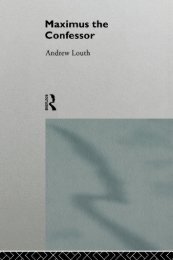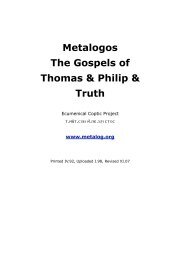Gospels of Thomas and Philip and Truth - Syriac Christian Church
Gospels of Thomas and Philip and Truth - Syriac Christian Church
Gospels of Thomas and Philip and Truth - Syriac Christian Church
You also want an ePaper? Increase the reach of your titles
YUMPU automatically turns print PDFs into web optimized ePapers that Google loves.
Introduction<br />
In December <strong>of</strong> 1945 two Muslim Egyptian farmers, Muhammad ‘Alí al-<br />
Sammán <strong>and</strong> his brother Khalífah ‘Alí, found over 1100 pages <strong>of</strong> ancient<br />
papyrus manuscripts buried by the east bluff <strong>of</strong> the upper Nile valley. The<br />
texts were translations from Greek originals into Coptic, the Hellenistic<br />
stage <strong>of</strong> the ancient Hamitic language <strong>of</strong> the Pharaohs (Gen 10:6). This<br />
dialect evolved after the invasion <strong>of</strong> Alex<strong>and</strong>er the Great in 332 BC, <strong>and</strong><br />
was subsequently replaced by Arabic as the Egyptian vernacular following<br />
the Muslim conquest <strong>of</strong> 640 AD. Coptic was thus the tongue <strong>of</strong> the<br />
primitive Egyptian <strong>Church</strong>, <strong>and</strong> remains its liturgical language unto the<br />
present day.<br />
The site <strong>of</strong> this discovery, across the river from the modern town <strong>of</strong><br />
Nag Hammadi, was already famous as the location called in antiquity<br />
ΧΗΝΟΒΟΣΚΕΙΟΝ (‘Goose-Pasture’), where in 320 AD Saint Pachomius<br />
founded the earliest <strong>Christian</strong> monastery. Less than a half-century later in<br />
367 AD, the local monks copied some 45 diverse religious <strong>and</strong><br />
philosophical writings— including the <strong>Gospels</strong> <strong>of</strong> <strong>Thomas</strong>, <strong>Philip</strong> <strong>and</strong> <strong>Truth</strong>,<br />
as well as part <strong>of</strong> Plato’s Republic (588A-589B)— into a dozen leather-<br />
bound codices. This entire library was carefully sealed in an urn <strong>and</strong><br />
hidden nearby among the rocks, where it remained undetected for almost<br />
1600 years. These papyri, first seen by scholars in March <strong>of</strong> 1946 (Jacques<br />
Schwarz & Charles Kuentz, Codex II, in a Cairo antiquities shop), have<br />
since 1952 been preserved in the Coptic Museum <strong>of</strong> Old Cairo. The earliest<br />
photographic edition <strong>of</strong> the manuscript <strong>of</strong> the preeminently important<br />
Codex II was edited by Dr Pahor Labib (Cairo: Government Antiquities Dept,<br />
1956).<br />
The author <strong>of</strong> the Gospel <strong>of</strong> <strong>Thomas</strong> is recorded as <strong>Thomas</strong> the<br />
Apostle, one <strong>of</strong> the Twelve. The text is a collection <strong>of</strong> over one hundred<br />
sayings <strong>and</strong> short dialogues <strong>of</strong> the Savior, without any connecting<br />
narrative. A few <strong>Christian</strong> authors in antiquity quoted one or another <strong>of</strong><br />
its logia as Scripture— for example Sayings 2 22 27 37 by Clement <strong>of</strong><br />
3




